Nantmel is a village situated about three miles NNW of Llandrindod Wells, on the A44 main road between Rhayader and Crossgates. The men of the area who fell during both World Wars are commemorated on the village war memorial, which is located in the car park in front of the school. Those who fell during the Great War are commemorated on the base of the cross, while those who fell during World War Two were obviously added later, on a face below the main base.
The Great War, 1914-1918
Thomas William Bird, Private, 38306, Cheshire Regiment. Thomas was the son of Andrew and Emma Bird, of Adforton, Leintwardine. He was a farmhand at Nantmel prior to enlisting at Knighton into the 19th Battalion, Welsh Regiment on 20 May 1915. He trained with the battalion at Colwyn Bay, but when the 19th Welsh embarked for France with the 38th (Welsh) Division, he must have been medically unfit for infantry work and stayed behind, transferring to the 21st Welsh. On 28 May 1916 he landed in Le Havre and was posted to the 19th Battalion, Cheshire Regiment. The battalion was a Labour Battalion and was utilised for work behind the front line, such as repairing roads and railways, and even burying the dead. On 1 March 1917 Thomas was admitted to the 2nd Australian Field Ambulance, after taking ill and was evacuated to No. 8 General Hospital, Étaples. He died of broncho-pneumonia on 7 March 1917, aged 28, and is buried in Étaples Military Cemetery, France. Thomas is also commemorated on the Rhayader War Memorial.
Evan Thomas Davies, Private, 51663, Cheshire Regiment. Evan was born at Faldlace Farm, Llanyre in 1891, the son of Evan and Sarah Jane Davies. He worked as a waggoner for David Mills at Newbridge-on-Wye prior to the war and enlisted at Knighton into the King’s Shropshire Light Infantry on 31 May 1917. He was posted to Pembroke Dock for training with the 3rd Battalion, KSLI and after training embarked at Southampton for France on 19 October 1917. Upon arrival in France he briefly joined the 5th Battalion, KSLI, but within days was transferred to the 15th Battalion, Cheshire Regiment. The battalion was attached to 105 Brigade, 35th Division, and was at Ypres, taking part in the Battle of Passchendaele. By the spring of 1918 the division was back on the Somme, and fought at the First Battle of Bapaume, during the German Offensive, and took part in a fighting withdrawal to Bouzincourt, where it was relieved by the 38th (Welsh) Division. The division remained in the area over the coming weeks, and after a spell in reserve moved back into the front to the left of the 38th Division. Evan was badly wounded in the thigh during an assault on Aveluy Wood on 1 June 1918. He was evacuated to the 107th Field Ambulance before being sent to the Base Hospital at Le Treport where he died of his wounds on 5 June 1918, aged 26. Evan is buried in Mont Huon Military Cemetery, Le Treport, France. He is also commemorated on the Llanyre and Newbridge-on-Wye War Memorials. His name appears to be an addition on the Nantmel memorial.
Frederick Farmer, Private, 27744, Border Regiment. Frederick was the son of Evan Farmer and Mary Farmer (nee Lewis), of Criggin, Nantmel. He enlisted at Rhayader into the Herefordshire Regiment and was posted to France in 1916, joining the 11th Battalion, Border Regiment. The battalion had been raised by the Earl of Lonsdale in September 1914 and landed in France on 23 November 1915 attached to 97 Brigade, 32nd Division. The division moved to the Somme sector and on 1 July 1916 took part in the opening offensive of the Battle of the Somme from their positions between Authille Wood and Thiepval Wood, but suffered terrible casualties before the survivors of the division were withdrawn. The Lonsdales were in camp at La Vicogne at the beginning of November 1916 and on 13 November began to move forwards towards the front line at Redan Ridge, reaching their positions on the 17th and began to prepare to launch an assault on the following morning. At 6.10 on the morning of 18 November 1916 the Lonsdales arose from their trenches and began to advance on the German line at Munich Trench under very heavy machine-gun and artillery fire. Frederick was among many men killed during the assault that day. He was 18 years old and is commemorated on the Thiepval Memorial, France. Frederick is also commemorated on the Rhayader War Memorial.
Thomas Francis, Private, 18035, King’s Shropshire Light Infantry. Thomas was born at Court Bytake, Montgomery in 1894, the son of Thomas Francis and Susannah Francis (nee Williams), and was baptised at Montgomery on 12 July 1894. His father was an agricultural worker and shepherd, and over the coming years the family moved several times, including to Upper Barn Cottage, New House, Shipton, Much Wenlock; The Outtrack, Craven Arms; and later to The Tally Ho, Boulden, Diddlebury, Craven Arms. Thomas had worked at Tryfal, Nantmel and at Nantymynach, Nantmel prior to enlisting at Shrewsbury together with his elder brother William into the King’s Shropshire Light Infantry on 24 May 1915, and after training at Pembroke Dock, the brothers embarked for France on 27 October 1915, before being posted to the 7th Battalion, King’s Shropshire Light Infantry. The battalion had only been in France a month, initially attached to 76 Brigade, 25th Division, but by the time the brothers joined its ranks, was at Ypres attached to 8 Brigade, 3rd Division, the Division having been relieved from the Sanctuary Wood sector a week earlier, moving to a rest camp in the Steenvoorde area. On 23 November the Division moved back into the line, taking over the section running between St. Eloi and Hill 60, and the 7th KSLI marched to Reninghelst that day, in Divisional reserve. The new sector was situated just south of the Ypres-Commines canal in the southern neck of the salient, the line facing roughly south-east. Headquarters of the 7th KSLI was situated in Spoil Bank and the feature known as The Bluff was on the opposite bank of the canal. The battalion remained here over the coming months, rotating in the front line with the 1st Northumberland Fusiliers until early February 1916, when the Division moved to Eperlecques for a rest. Less than two weeks later, on 14 February, the Germans launched an offensive against the Ypres Salient, capturing The Bluff, so the 3rd Division was ordered back into the line to recapture the lost ground. On 2 March 1916, 8 Brigade supported an assault by 76 Brigade against The Bluff, an action which saw the 10th RWF, in the latter Brigade, decimated. The 7th KSLI took over the new front line, which it consolidated, before being relieved on the night of 7-8 March, and moved back to Reninghelst. On 11 March the battalion moved back into its old sector on the Spoil Bank south of the canal, and on 19 March took up reserve positions for an assault by 9 Brigade on the Mound at St. Eloi, remaining in the sector over the coming weeks. Thomas was killed at St. Eloi on 3 April 1916, just hours before the 7th KSLI was relieved. The 23-year-old has no known grave and is commemorated on the Ypres (Menin Gate) Memorial, Belgium. His brother, William, had been wounded at St. Eloi and had died of his wounds the previous day.

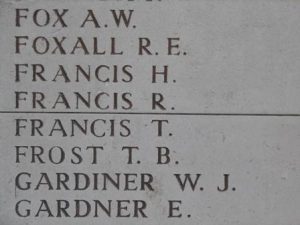
Albert Edward Hughes, Private, 3110, Montgomeryshire Yeomanry. Albert was the son of Edward and Rosetta Maud Hughes, of Glasllyn Lodge, Nantmel. He enlisted at Rhayader into the 2/1st Battalion, Montgomeryshire Yeomanry and was posted to Ireland with a number of other men from the regiment, joining the 6th Reserve Cavalry Regiment at The Curragh. Albert took ill and died of meningitis on 6 September 1915, just three months after arriving at The Curragh. He was 19 years old and is buried in St. Bridget’s Cathedral Cemetery, Kildare. He is also commemorated on the Rhayader War Memorial.
David James Jones, Private, M/427214, Royal Army Service Corps. David was the son of David and Jane Jones, of Glandwr Cottage, Penybont Station. He had married Sarah Lewis on 14 December 1908. Sadly, Sarah had died soon after the birth of their daughter, Elsie Lily Jones, on 7 March 1909. David worked as a railway platelayer prior to the war and enlisted into the Railway Troops Depot, Royal Engineers at Knighton on 24 January 1916. He served with the Royal Engineers until October 1918 when he was transferred to the Motor Transport, Royal Army Service Corps, but took ill and died at Brooklyn V.A.D. Hospital, Sydenham, on 22 November 1918, aged 31. His remains were brought home and he was buried in St. Padarn’s Churchyard, Llandrindod Wells. David is also commemorated on the Rhayader War Memorial.
James Jones. This man cannot presently be identified.
Joseph Jones. This man cannot presently be identified.
W. J. Jones. This man cannot presently be identified.
Octavius Hughes Lewis, Private, 17267, King’s Shropshire Light Infantry. Octavius was the son of Thomas and Ann Lewis, of Gilfach, Nantmel. He worked on his father’s farm prior to enlisting at Rhayader into the 5th Battalion, King’s Shropshire Light Infantry, and served with D Company. The battalion was attached to 42 Brigade, 14th (Light) Division and landed at Boulogne on 20 May 1915. The division moved to the Ypres sector and saw its first major action at Hooge, when it became the first British division to be attacked by flamethrowers. The division remained at Ypres over the coming months and on 25 September 1915 took part in a diversionary attack, to attempt to divert German attention away from the offensive which had been launched at Loos that same day. The 5th KSLI launched its attack at 04.20 and managed to penetrate the German second line, but the attack to the right had failed and within four hours the battalion was forced to withdraw, coming under heavy artillery fire. Octavius was among over 400 casualties suffered by the 5th KSLI that day. The 25-year-old has no known grave and is commemorated on the Menin Gate Memorial, Ypres.
Robert Evan Lewis-Lloyd, Lieutenant, Royal Navy. Robert was born at Taunton on 6 April 1895, the son of Robert Wharton Lewis-Lloyd and Elizabeth Alice Lewis-Lloyd (nee Williams). By 1901 the family was living at Elizabeth’s native Nantmel. He enlisted into the Royal Navy after leaving school and by the end of 1917 had been promoted to Lieutenant and was serving aboard the M-class destroyer HMS Opal. She had been commissioned in April 1916 and saw action during the Battle of Jutland whilst attached to the 12th Destroyer Flotilla, based at Scapa Flow as part of the Grand Fleet. On 12 January 1918, Opal joined her sister ship Narborough and the light cruiser Boadicea in a night patrol to hunt German warships off the Scottish coast. The weather was so bad that the ships were in danger of founding, so were ordered back to Scapa Flow, but whilst making their way back, both of the destroyers struck rocks and foundered in the heavy seas, causing the loss of all bar one single survivor. Robert was 22 years old when he died that day, and is commemorated on the Portsmouth Naval Memorial, Hampshire. He is also commemorated on the Rhayader War Memorial.
Thomas Herbert Meredith, Corporal, 1129, Australian Infantry. Thomas was the son of Morgan Price Meredith and Jane Eliza Meredith, of Nantmel. He had served, together with his brother Morgan, during the Boer War with the Imperial Yeomanry. Following the war, he emigrated to Australia where he found work as a labourer. He enlisted at Sydney into the 1st Battalion, Australian Infantry on 6 October 1914 and was posted to ‘A’ Company. The battalion embarked from Sydney, New South Wales, on board Transport A19 Afric on 18 October 1914, bound for Egypt, with the 1st Australian Division. The Australians were originally to be moved to the Western Front, but upon arrival in Egypt it was decided to keep them there to take part in a planned invasion of the Gallipoli Peninsula, in order for the Allies to force a passage through the Dardanelles straits and capture Istanbul. On 25 April 1915 Thomas landed with his battalion at Anzac Cove, Gallipoli and the Australians advanced up a steep hill to attack the Turks. The landings were a disaster and none of them proved successful, the Allies only gaining a foothold, so the campaign bogged down into trench warfare almost immediately. Thomas was shot in the head while the battalion was in the line at Quinn’s Post, and was evacuated aboard the Hospital Ship Gascon. He died at sea three miles off the peninsula on 26 June 1915, aged 38, and was buried at sea. Thomas is commemorated on the Helles Memorial, Gallipoli.
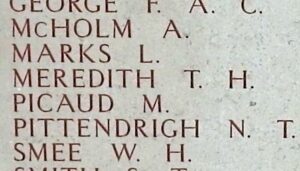
Benjamin Michael, Sapper, 67220, Royal Engineers. Benjamin was born at Nantmel in about 1890. He resided at Maesygelly, Nantmel prior to the war and worked as a carpenter. He enlisted at Rhayader into the Royal Engineers and was posted to the 126th Field Company, RE, which was attached to the 21st Division. He embarked for France with his unit on 12 September 1915, and the entire division assembled in the Loos sector. Fresh from England, the division was thrown into battle at Loos on 26 September, and suffered over 3,800 casualties for very little gain. The division moved to the Somme in 1916, and fought throughout the offensive. In March 1917 the division followed the German Retreat to the Hindenburg Line, and in April fought at Arras, during the First Battle of the Scarpe, the Third Battle of the Scarpe, and the Flanking Operations Round Bullecourt. Benjamin was killed in action here on 15 August 1917, just prior to the division leaving for Ypres. He was 27 years old and is buried in St. Leger British Cemetery, France. He is also commemorated on the Rhayader War Memorial.
William Thomas Middleton, Private, 19857, King’s Shropshire Light Infantry. William was the son of Philip and Elizabeth Middleton, of Vulcan Arms, Doldowlod, Rhayader. He enlisted at Knighton into the 7th Battalion, King’s Shropshire Light Infantry. The battalion was attached to 76 Brigade, 25th Division and landed at Boulogne on 28 September 1915, moving to the Ypres sector. 76 Brigade was then transferred to the 3rd Division at Ypres. William would have taken part in heavy fighting with the 7th KSLI during the Actions of the Bluff, and at the St Eloi Craters early in 1916, then during July 1916 the battalion moved south with the 3rd Division to the Somme sector. On 14 July the division took part in its first fighting on the Somme, during the Battle of Bazentin Ridge. Over the coming days the 7th KSLI suffered the loss of eight officers and 163n other ranks killed; seven officers and 294 other ranks wounded. The battalion had lost most of its original men, but William had, for now, survived. The remnants of the battalion moved into reserve to rebuild before moving back into the front by 18 August 1916, taking up positions south-east of Montauban. William was killed in action here that day, while the 7th KSLI was in support of an attack by the 10th RWF against Maltzhorn Farm. He was 24 years old and is buried in Guillemont Road Cemetery, Guillemont, France. William is also commemorated on the Rhayader War Memorial.
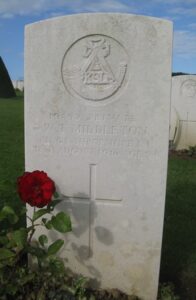
David Joseph Mills, Private, M2/174967, Royal Army Service Corps. David was the son of William and Hannah Mills, of Clewedog Cottage, Penybont Station. He worked as a gardener prior to enlisting at Llandrindod into the Army Service Corps and was posted to East Africa with the 648th Motor Transport Company, Army Service Corps. The British had a force in East Africa which had been built up to combat the guerrilla warfare employed by German led troops in the area. David became ill and died of disease in Tanzania on 19 November 1917, aged 32. He is buried in Dar Es Salaam War Cemetery, Tanzania. David is also commemorated on the Llandrindod Wells and Rhayader War Memorials.
Samuel Charles Pritchard, Private, 25621, Grenadier Guards. Samuel was the son of William and Fortune Pritchard, of Hill House, Penybont Station. He worked as a postman prior to enlisting at Knighton into the Grenadier Guards and was posted to France in 1916, joining the 2nd Battalion, Grenadier Guards, which was attached to the 1st Guards Brigade, Guards Division. During July 1916 the Division moved from the Loos area to the Somme, and took part in the Battle of Flers-Courcelette, the first time that tanks were used in warfare. The division then took part in the Battle of Morval, capturing Lesbœufs Village. It remained here for the winter, which was particularly harsh. Samuel had taken ill during this time and died of pneumonia on 14 February 1917, aged 23. He is buried in Grove Town Cemetery, Méaulte, France. Samuel is also commemorated on the Rhayader War Memorial.
Edward William Rees, Guardsman, 3672, Welsh Guards. Edward was the son of James and Mary Rees, of Penpistyll, Nantmel. He enlisted into the Welsh Guards and was posted to France to join the 1st Battalion, Welsh Guards. The Regiment was raised by Royal Warrant of 26 February 1915, at White City, before landing at Le Havre on 18 August 1915, becoming attached to 3rd Guards Brigade, Guards Division. The Division saw its first major action during the Battle of Loos, which began on 25 September 1915, remaining in the area during the coming months, where they also fought in the subsequent Action of Hohenzollern Redoubt. In July 1916 the Division moved to the Somme, where it fought at the Battle of Flers-Courcelette, and then at the Battle of Morval, capturing Lesboeufs Village. The division remained here for the winter, and in March 1917 took part in the advance caused by the German Retreat to the Hindenburg Line. Later that year it moved north to Ypres and fought at the Battle of the Pilkem Ridge, the opening phase of the Passchendaele offensive. The Guards Division saw further fighting at Ypres, during the later stages of the offensive, before being moved south, taking part in the Battle of Cambrai and by the end of November was in the thick of the action. Edward was killed during an attack near Gouzeaucourt on 1 December 1917. Losses among the Welsh Guards were heavy during the days fighting. Edward was 19 years old and is commemorated on the Cambrai Memorial, Louverval, France. He is also commemorated on the Rhayader War Memorial. His brother, James, died of wounds just three months later.
James Humphreys Rees, Gunner, 214958, Royal Field Artillery. James was the son of James and Mary Rees, of Penpistyll, Nantmel. He worked as a farm hand at Llawrllan Farm prior to enlisting at Knighton into the Royal Field Artillery and was posted ‘C’ Battery, 331st Brigade, RFA, which was attached to the 66th Division. The battery embarked for France with the division in March 1917, which moved to the Flanders Coast. At the end of September 1917, the division moved to Ypres, and took part in the Battle of Poelcapelle. It then moved south to the Somme, and on 21 March 1918 was hit by the German Spring Offensive, taking part in an epic rear-guard action over the coming days. James was seriously wounded during the first day of the offensive and was evacuated to the base hospital at Amiens where he died of his wounds on 24 March 1918, aged 21. He is buried in St. Pierre Cemetery, Amiens, France. He is also commemorated on the Rhayader War Memorial.
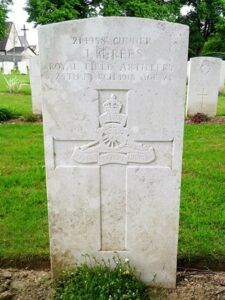
World War Two, 1939-1945
Arthur Corfield Somerset Clive-Davies, Sergeant, 1332179, Royal Air Force Volunteer Reserve. Arthur was the son of Colonel Arthur Lionel Clive-Davies and Audrey Veronica Clive-Davies, of Nantmel. He enlisted into the Royal Air Force Volunteer Reserve and after training was posted to 201 Squadron, RAF. The squadron had originally formed as No 1 Squadron, RNAS in 1914 and following the creation of the RAF in 1918 was renumbered 201 Squadron. It was flying the Saro London and Supermarine Stranraer at the outbreak of war, but soon re-equipped with the Short Sunderland, tasked with convoy escort and anti-submarine duties. On 1 August 1942, Arthur was flying aboard Sunderland III, Serial W4000, which had been despatched to escort the ships assembling to form convoy WS21 in the Clyde, when the Sunderland was brought down by friendly anti-aircraft fire in poor visibility, and crashed into the sea. Only one man survived, the remainder of the crew, eleven men, including Arthur, were killed. Arthur was 21-years-old when he died that day and is commemorated on the Runnymede Memorial, Surrey.
Mervyn Davies, Private, 14574334, The Queen’s Royal Regiment (West Surrey). Mervyn was the son of Evan James Davies and Blodwen Davies, of Abercamlo Farm, Llandewy Ystradenny. He enlisted into the army and was posted to the 1st Battalion, The Queen’s Royal Regiment. The battalion was in India at the start of the Second World War and fought for a year against Afghan tribesmen on the North-West Frontier. The Battalion then transferred to Burma to the 7th Indian Division and saw heavy fighting against the Japanese in the Arakan, at Kohima and in the final phase of the war, during the crossing of the Irrawaddy. Mervyn was killed in Burma on 14 June 1945, aged 20. He is buried in Rangoon War Cemetery, Myanmar. The inscription on the base of his headstone reads: ‘LOVED AND REMEMBERED ALWAYS. MOTHER, BROTHERS AND SISTERS’.
Martin Ricardo Gibson-Watt, DSC, Lieutenant, Royal Navy. Martin was born in Stroud in 1920, the son of Major James Miller Gibson-Watt and Marjorie Gibson-Watt (née Ricard). His father, from Nantmel and a descendant of the Scottish engineer James Watt, had served with the South Wales Borderers during the Great War, while his mother was the daughter of Henry and Adela Ricardo, of Gatcombe Park, and the couple moved to the Watt family home at Doldowlod, Llanyre after their marriage. Martin joined the Royal Navy prior to the war and passed as a Midshipman on 1 January 1938. His first wartime posting was as a Sub-Lieutenant aboard the D-class destroyer HMS Dainty. The destroyer took part in the Mediterranean convoys and had towed the disabled tanker Desmoulea to Suda Bay after it had been torpedoed by an Italian torpedo boat off Crete on 31 January. Dainty then returned to patrol the North African coast and on the afternoon of 24 February 1941 she had just left Tobruk with HMS Hasty when the ships were attacked by German Ju-88 bombers and Hasty was set ablaze, before sinking. Martin gained the award of the Distinguished Service Cross for his actions during the sinking of his ship. He was then promoted to Lieutenant and posted aboard the K-class destroyer HMS Kandahar. On 19 December 1941, Kandahar was part of British Force K, tasked to intercept an Italian convoy bound for Tripoli when she struck a newly laid Italian mine whilst attempting to rescue the stricken cruiser Neptune. Martin was one of 73 men killed in the explosion. The stricken Kandahar was scuttled the following day. Martin was just 21-years-old when he was killed on 19 December 1941 and is commemorated on the Plymouth Naval Memorial, Devon.
Edward Ingram, Guardsman, 2736377, Welsh Guards. Edward was born on 14 June 1915, the son of Thomas and Ada Ingram, of Nantmel. He married Sylvia Alice Davies in 1941. Edward worked as a gardener prior to enlisting into the Welsh Guards and was posted to the 2nd Battalion, Welsh Guards. The battalion had been formed on 18 May 1939 and embarked for France on 21 May 1940 to cover the withdrawal from Boulogne and formed a perimeter around the docks where it was attacked that same night by German infantry supported with Panzers. The battalion lost over 450 men during heavy fighting in Boulogne and rebuilt in the Codford area. Edward died during this period, on 25 August 1941, aged 26. His remains were brought home and he was buried in St. Cynllo’s Churchyard, Nantmel. His widow, Sylvia, later resided at Cwmfelinfach, Monmouthshire. The inscription at the base of Edward’s grave reads: “DEARER STILL AS YEARS DEPART HIS MEMORY LIVES WITHIN OUR HEARTS”.
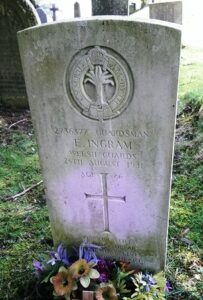
John Eric Jones, Bombardier, 924117, Royal Artillery. John was the son of Edward and Mary Ann Jones, of Upper-Gaufron, Nantmel. He was a pharmaceutical student at Swansea when war erupted and enlisted into the Royal Artillery, being posted to the 133rd Field Regiment, RA, which was attached to the 53rd (Welsh) Division. John married Florence Josephine Marpole, of Upper-Gaufron, whilst on leave in 1943. He returned to his unit at Herne Bay, and died there on 24 May 1944, just a month prior to the division embarking for Normandy. John was 30 years old and his remains were brought home for burial in St. Cynllo’s Churchyard, Nantmel.
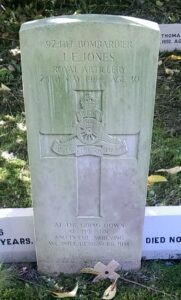
Albert Mason, Fusiliers, 4197065, Royal Welch Fusiliers. Albert was the son of Arthur Price Mason and Alice Mason, of Cwmgest, Nantmel. He enlisted into the Royal Welch Fusiliers prior to the war and embarked for France with the 1st Battalion, Royal Welch Fusiliers, arriving at Cherbourg on 24 September 1939. The battalion moved to northern France and began working on a defensive line facing Belgium. When the Germans invaded the Low Countries on 10 May 1940, the battalion was moved to the village of Ottenburg as reserve to 6th Brigade. The battalion was ordered to withdraw on 14 May, but with no transport available was forced to withdraw towards by foot. Albert, who was 21-years-old, was one of five men killed during an engagement with an advance party of Germans on 15 May 1945. The five men are buried alongside each other in St. Agatha-Rode Churchyard, Belgium. Over the coming days the 1st RWF held a defensive line at St. Venant, attempting to keep the Dunkirk Corridor open, and lost its Commanding Officer, Lieutenant Colonel Harrison during an assault by SS troops. Only 80 men from the battalion managed to reach Dunkirk for evacuation on 31 May.
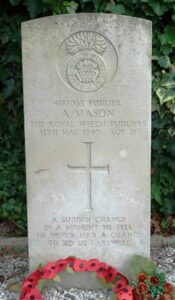
John Idris Price, Corporal, 510925, Royal Air Force. John was born in 1911, the son of Richard and Ada Evelyn Price, of Esgairannos, Nantmel. He enlisted into the Royal Air Force several years prior to the war and married Olive Julia Gange whilst based near Salisbury in 1934. Following the outbreak of war John was posted to 53 Squadron, RAF, which was based at RAF Detling, in Kent. The squadron was at the time attached to Fighter Command and was equipped with the Bristol Blenheim. During the afternoon of 13 August 1940, the staff at Detling were going about their daily business when the airfield came under attack by German Stuka dive-bombers. The airfield sustained several direct hits, and around 100 RAF and civilian personnel were killed or wounded. John was among the dead. He was 29 years old and was buried alongside many of the casualties of the attack in Maidstone Cemetery, Kent. The inscription at the base of his headstone reads: ‘HIS IS A CROWN OF GLORY. ALWAYS IN OUR THOUGHTS. HIS LOVING WIFE AND CHILDREN’.
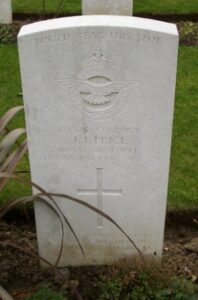
Sidney George Pugh, Private, 14664595, Royal Welch Fusiliers. Sidney was the son of William Henry and Kate Pugh, of Nantmel. He enlisted into the army and was posted to the 2nd Battalion, Royal Welch Fusiliers. The battalion was part of 29th Independent Infantry Brigade and in 1942 fought in the Battle of Madagascar. The Brigade was then transferred to Burma, becoming attached to the 36th Infantry Division, and fought in Burma from August 1944 as part of the 14th Army, under General Slim. The Division then took part in the advance to Mandalay and saw action during several fierce battles, especially in the Arakan from 1 January – 12 June 1944. From 12 Febryary 1945 the Division was fighting around Mandalay, and it was here, on 2 March 1945, that Sidney was killed. He was 23 years old and is buried in Taukkyan War Cemetery, Myanmar.